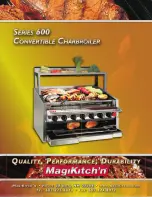
48
BOILER CONTROL: OPERATION
k. Mild Weather Point: The mild weather point is
defined by the mild weather outdoor temperature
and the mild weather boiler temperature.
l. Mild Weather Boiler Temperature: This is the
minimum temperature that the boiler will target to
satisfy a CH demand. In radiant floor design, this
temperature can be set very low. However, avoid
setting the temperature too low in systems with
limited radiator surface and in lower floors with
open stairways that can allow heat to migrate up
to higher floors.
m. Mild Weather Outdoor Temperature: This
temperature is the highest outdoor temperature at
which the boiler is expected to run. The default
value for this is 70 which equals the default warm
weather shutdown value.
The example in Figure 8.35 shows an outdoor
temperature of 0°F (-18°C) which corresponds
to the value for Springfield, Massachusetts. The
boiler temperature is shown at 160°F (71°C)
to meet the load as determined by the system
designers. The mild weather point is at an
outdoor temperature of 70°F (21°C) and a boiler
temperature of about 85°F (29°C). When the
outdoor temperature is 32°F (0°C), the boiler will
target 130°F (54°C).
n. Boiler Limits: The boiler limits are available to
limit the minimum and maximum temperature
that the boiler can target. Note that these limits will
override the values set in the outdoor reset design
and mild weather outdoor reset parameters.
o. Boiler Min: The boiler will not target a temperature
lower than what is chosen in this menu screen.
The default for this is, “Off” since low temperatures
will not affect the boiler. However, it may be useful
in installations that require a minimum temperature
to operate (like a fan coil unit that will not allow a
fan to operate below a certain temperature).
p. Boiler Max: The boiler will not target a
temperature higher than that chosen in this menu.
This can be useful to prevent damage due to high
temperatures in temperature sensitive situations
such as radiant floors.
q. Boost: The boost function is designed to compensate
for a system that is not meeting the required load.
If there is a constant call for central heat for the
length of time specified, the target temperature will
be increased by the temperature value selected. The
boiler will never target a temperature higher than
that specified by the boiler max. parameter.
There are several reasons why the boost function
may or may not be implemented.
•
In buildings which have many zones, there may
seldom be a period when none of the zones is
calling for heat. In this case, the boiler will very
often be operating at the temperature selected
by the “boiler max.” parameter, and much
of the advantage of a condensing boiler may
be lost. Therefore, it may be better to use CH
Mode 2, “Permanent Demand and Outdoor
Reset” in these situations. In this mode, the
boost function is not applied therefore the
boiler will continue to run at the temperature
calculated by the outdoor reset algorithm.
•
Programmable thermostats can give a building
owner the ability to set back the thermostat
significantly during unoccupied periods.
After an aggressive setback, it may take the
boiler a significant amount of time to recover.
However, this may lead to the boiler frequently
operating at higher temperatures, where it is
less efficient. Before using setback thermostats,
the building owner should be made aware that
aggressive setback s of 10°F (6°C) or more may
not have the desired effect.
•
If the outdoor reset parameters are set for
design conditions at a certain outdoor design
temperature, and the outdoor temperature
drops below that temperature for a significant
amount of time causing cold indoor
temperatures, the boost function can allow the
boiler to target temperatures up to the boiler
maximum to satisfy the load.
Table 8.21: Reset Curve Min/Max Ranges & Defaults
Table 8.22: Temperature Boost Ranges & Defaults
Parameter
Minimum
Default
Maximum
Boost Temperature
0°F (0°C)
18°F (10°C) 36°F (20°C)
Boost Time
1 minute
20 minutes
60 minutes
Table 8.20 Reset Curve Mild Weather Ranges &
Defaults
Parameter
Minimum
Default
Maximum
Mild Weather
Boiler Temp.
36°F (2°C)
70°F (21°C) 160°F (71°C)
Mild Weather
Outdoor Temp.
36°F (2°C)
70°F (21°C) 85°F (29°C)
Parameter
Minimum
Default
Maximum
Boiler Minimum “Off” or 40°F (4°C)
OFF
180°F (82°C)
Boiler Maximum
81°F (27°C)
195°F (91°C) 195°F (91°C)
Figure 8.37: CH Settings – Reset Curve Mild
Weather
Managing Burner Only
Figure 8.38: CH Settings – Reset Curve Min/Max
Managing Burner Only
Figure 8.39: CH Settings – Temperature Boost
Managing Burner Only
Summary of Contents for PUREFIRE PFC-1000
Page 1: ...PUREFIRE Boilers PFC 850 PFC 1000 PFC 1500 Gas Installation Operation Maintenance Manual ...
Page 82: ...80 Figure 13 4 Control System REPAIR PARTS ...
Page 84: ...82 Figure 13 5 Condensate System REPAIR PARTS ...
Page 90: ...88 APPENDIX C USER MENU APPENDIX C USER MENU Figure C 1 User Menu Managing Burner ...
Page 91: ...89 APPENDIX C USER MENU Figure C 1 User Menu Dependent Burner ...
Page 92: ...90 APPENDIX D INSTALLER MENU STRUCTURE APPENDIX D INSTALLER MENU STRUCTURE ...
Page 93: ...91 APPENDIX D INSTALLER MENU STRUCTURE ...
Page 95: ...93 SERVICE LOG SERVICE LOG Date Serviced By Description of Service Serial Number ...
Page 96: ...94 NOTES ...
Page 97: ...95 NOTES ...
















































